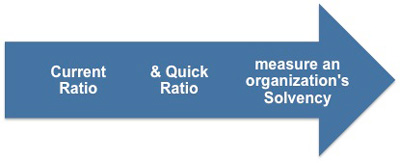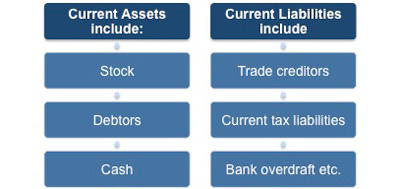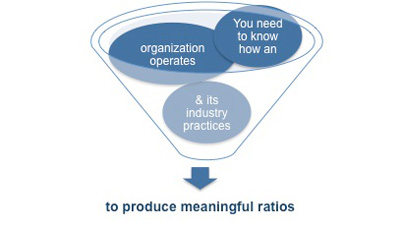Financial Statement Analysis - Current Ratio Analysis
An organization is considered to be solvent when it has sufficient working capital to pay its debts as they become due.
 |
There are two key ratios that can help you to determine whether an organization is solvent:
• Current ratio
• Quick ratio
Current Ratio
The current ratio looks at the relationship between current assets and current liabilities. The word 'current' implies short-term assets or liabilities, which are payable or receivable within one year.
 |
These figures are always shown on the balance sheet. To calculate this ratio you would divide current assets by current liabilities.
 |
For example: An organization has:
• Current assets of $200,000
• Current liabilities of $100,000
Its current ratio calculation would be $200,000 ÷ $100,000
The current ratio would be expressed as 2:1
This ratio of 2:1 would be considered a healthy result as it shows that the organization has sufficient current assets to pay its current liabilities as soon as they are due.
Quick Ratio
The quick ratio, or acid test ratio, measures liquidity more precisely than the current ratio. It does not include the value of stock within current assets because turning stock into cash takes time since payment terms are usually anything between 30 and 90 days.
You can calculate the quick ratio by dividing current assets (excluding stock) by current liabilities. You can find the stock or inventory figure on the balance sheet.
 |
For example: An organization has:
• Current assets of $200,000
• Stock worth $80,000
• Current assets (less stock) of $120,000
• Current liabilities of $100,000
Its current ratio calculation would be $120,000 ÷ $100,000
The current ratio would be expressed as 1.2:1
This example shows that an apparently healthy level of current assets might hide the fact that a large proportion of the current assets is made up of stock. Whilst this can usually be turned into cash, it will take time and to do it quickly might require heavy discounting.
When you need to review the liquidity of an organization, it is common practice to calculate both the current ratio and quick ratio. This is so that you are aware of the extent to which stock held influences its current assets. These calculations will quickly show you if the level of stock an organization holds is too great and also whether it matches your expectations of the industry.
 |
You must always be careful when drawing conclusions from these accounting ratios. It is quite possible that an organization may appear to be desperately short of working capital, but if it sells goods for cash and purchases with a long credit line, then it may be that it is being very well managed.
It is vital that you understand what the organization actually does and the industry it operates in before you draw any conclusions from these ratios. This Key Financial Ratios Checklist details the key financial ratios you can use to help you interpret financial information. This Financial Ratio Formulas Checklist provides you with a list of the most popular financial ratios used to assess an organization's performance, solvency, profitability and investment potential. If you need a basic financial accounting principles pdf then download our free eBook now.
You may also be interested in:
Financial Statement Analysis | Key Accounting Ratios | Types of Key Accounting Ratios | Calculating Profit | Business Performance Ratios | Price/Earnings Ratios | Price-to-Book Ratio | PEG (Price/Earnings to Growth) Ratio | Dividend Yield.



